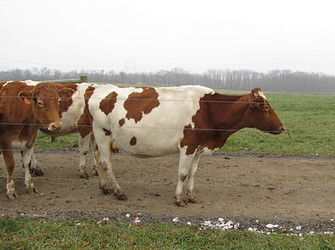top of page

Montgomery Soil Conservation District
Montgomery County, Maryland

Best Management Practices
Best Management Practices (BMPs) are designed to maintain or improve water quality and conservation while still allowing for healthy agricultural production. BMPs include topics such as nutrient management, structural barriers, and other water and field management practices.

Vegetative Practices

Critical Area Planting
Planting grass or other vegetation protects a severely eroding area from soil erosion.

Cover Crops
Cereal grains such as wheat, rye, oats, and barley are planted in the fall following the harvest of corn, soybeans, and vegetable crops.
Cover crops protect the soil from erosion and immobilize unused nitrogen from the root zone.

Pasture Planting
Planting grasses and legumes to improve forage production, improve livestock nutrition, and protect the soil from erosion and improve water quality.

Tree/Shrub Establishment
Establishing woody plants by planting seedlings or cuttings, direct seeding, or natural regeneration.

Riparian Buffer
Trees, shrubs, or grasses planted next to waterways (including rivers, streams, and drainage ditches) filter runoff, improve water quality, protect the soil from erosion, and provide wildlife habitat.
Vegetative
Structural Practices

Diversion
A long earthen embankment built across the slope to redirect runoff

Grade Control Structure
Earthen, wooden, concrete or other structure built across a drainageway to control and reduce water flow.

Grassed Waterway
Shaping and establishing grass in a natural drainageway to prevent gullies from forming and control soil erosion.

Heavy Use Area Protection
Stabilizing areas that are disturbed because of frequent and intensive use by livestock or farm equipment.

Livestock Watering System
A system of troughs and water lines to provide livestock with water from a spring, pond, or well.

Manure Storage Structure
These structures are used to store manure produced by livestock until conditions are right for field application or transport off the farm.

Roof Runoff System
A system for collecting, controlling and discharging runoff water from non-residential farm buildings.

Fencing
A constructed barrier to livestock, wildlife, or people.

Water Control Structure
A structure in a water management system that conveys water, controls the direction or rate of flow, maintains a desired water surface elevation or measures water.
Structural
Management Practices

Contour Farming
Tillage, planting and other farming practices performed on or near the contour of the field (not up and down the hill).

Crop Residue Management
Leaving residue from the previous crop on the soil surface for a specific period of time by reducing tillage.

Crop Rotation
Changing the crops grown in a field on a regular basis.

Integrated Pest Management
Evaluating and using a tailored pest management system to reduce crop and environmental damage. A range of management strategies is used only if pests reach threatening levels or begin to cause serious crop or plant damage.

Nutrient Management
Nutrient Management planning is a series of best management practices aimed at reducing nutrient pollution by balancing nutrient inputs with crop requirements.

Rotational Grazing
Managing pasture grazing by moving livestock from one area to another at the proper time to maintain high quality forage.
Management
bottom of page